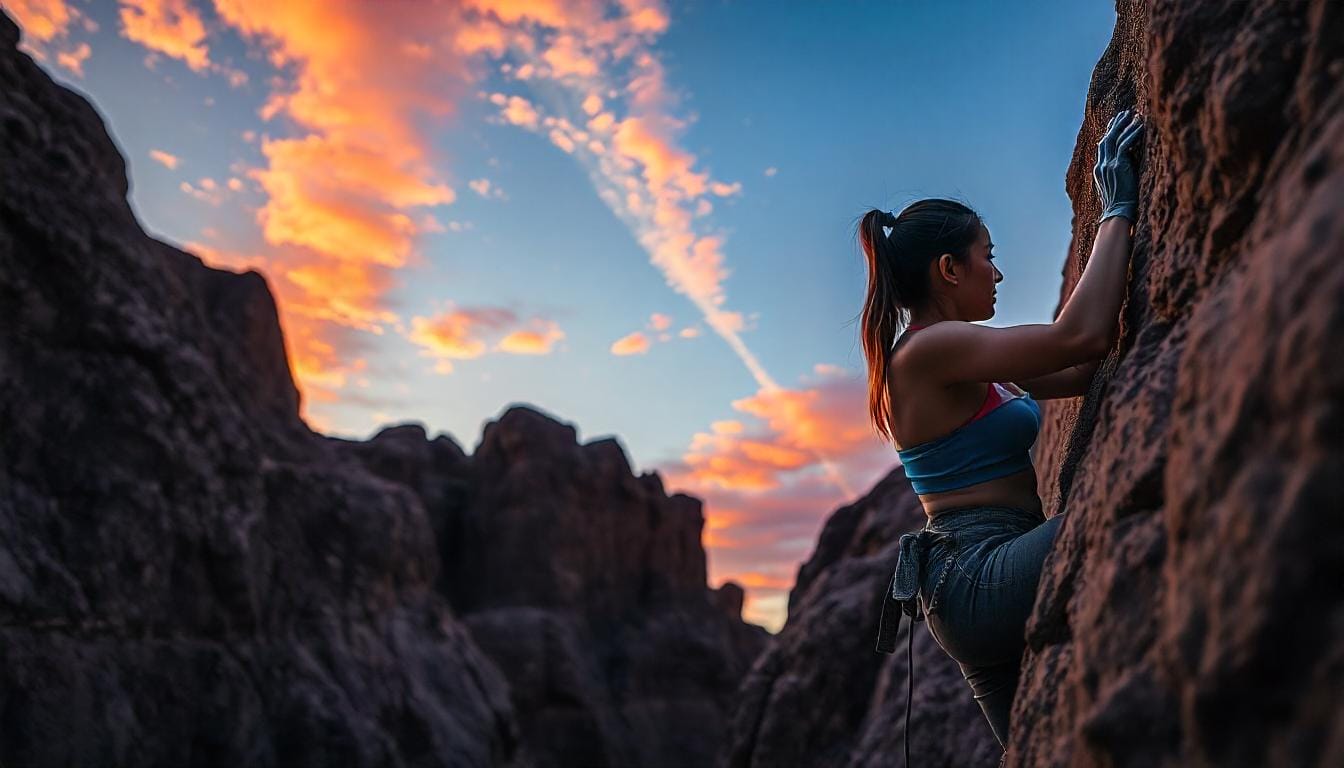Bouldering Basics covers what bouldering is and why people love it. Bouldering is a type of climbing done on short walls without ropes, according to the experts. This means almost anyone can try it, indoors or outdoors! Keep reading to uncover the gear, techniques, and tips to start bouldering. This article will teach you everything you need to know to take on this fun and challenging sport. Don’t miss out on the excitement of bouldering!
Key Takeaway
- Bouldering is climbing without ropes on short walls.
- Essential gear includes climbing shoes and chalk.
- Safety tips are important to enjoy bouldering safely.
What is Bouldering
Credits : theclimbinghangar
Bouldering is a type of rock climbing that does not use ropes or harnesses. It focuses on climbing short routes called “problems” on small rock walls or artificial surfaces. The walls are usually not taller than 20 feet high.
For bouldering, climbers use their strength and skills to make their way up these short but challenging climbs. It can be done indoors at climbing gyms or outdoors on natural rock formations. Indoor gyms have padded floors to help keep climbers safe if they fall. This makes bouldering very beginner-friendly. People of all ages can try it out. It is also a great way to build strength and improve climbing skills.
Bouldering is not just about getting to the top. It also involves figuring out how to solve each climb. Climbers need to think about the best way to approach every problem. This planning and problem-solving adds to the fun and challenge of bouldering.
In summary, bouldering is a rock climbing activity focused on short climbs without ropes. It works the body and mind. With padded floors indoors, it can be safe for beginners. Bouldering provides a full-body workout while also requiring creative thinking to map out the best route up (1).
Bouldering vs Rock Climbing
Bouldering and rock climbing are often compared, but there are some key differences between them. First, bouldering is done at much lower heights than rock climbing. Bouldering climbers usually stay below 20 feet tall walls, while rock climbing can go way higher than that. Since the walls are not as high, bouldering climbers do not need ropes or harnesses to keep them safe. Instead, they only depend on their own strength and climbing skills to get up the wall.
Another big difference is the amount of gear the climbers need. For bouldering, the main gear is climbing shoes and chalk for their hands. But for rock climbing, climbers need way more equipment like harnesses, ropes, and other gear. This makes it easier to start bouldering since it costs less money and is simpler to do.
Bouldering focuses on powerful climbing moves and techniques. The climbers work on being strong and skilled so they can climb the short but intense bouldering routes. Bouldering is great for people who love quickly solving tough climbing challenges. Rock climbing often has longer climbs that require more endurance from the climber. Both are exciting sports, but bouldering gives a one-of-a-kind experience that many find really appealing.
In summary, bouldering and rock climbing both involve climbing walls, but bouldering is done at shorter heights without ropes or harnesses. It requires less gear and is more about power and skill. This makes bouldering unique and fun in its own way.
Bouldering Equipment
To start bouldering, there are a few key pieces of gear climbers need. The most important item is a good pair of climbing shoes. These special shoes fit tightly and have rubber soles to grip the holds on the wall. A shoe that fits just right helps climbers feel more in control when climbing.
Another essential thing is chalk! Climbers use chalk on their hands to keep them dry and prevent slipping. Sweaty hands make climbing much harder. The chalk helps climbers’ hands stick better to the holds. Climbers carry chalk in a little bag called a chalk bag. The bag clips onto their waist for easy access during a climb.
For outdoor bouldering, a crash pad is also recommended. Crash pads are thick, cushioned mats placed on the ground. They help make falling safer since falling is part of bouldering. The pads soften the landing when climbers fall off the boulders outside.
While the gear may seem complicated at first, getting started with the basics is easy. Many climbing gyms rent out shoes and chalk so beginners can try bouldering without buying everything up front.
In summary, the key items climbers need are good shoes, chalk for their hands, and a crash pad for when climbing outside. With just these basics, anyone can start experiencing the thrill of bouldering!
Bouldering Etiquette
When bouldering, it’s important to follow some basic rules so everyone stays safe and has fun.
First, climbers should avoid blocking the paths where people are climbing. Keeping the areas clear lets everyone move around safely and easily.
Taking turns is another big rule. If someone is climbing a route, others should wait until they finish before trying it themselves. This shows respect and helps climbers focus without distractions.
When someone is about to jump down, it’s helpful to stand close by and spot them. This helps them land more safely.
Climbers should also cheer each other on. Bouldering is often social, and supporting friends can make it more enjoyable. Sharing tips on routes and techniques helps everyone get better.
Lastly, climbers should respect the climbing space, whether indoors or outdoors. Keeping the area clean and trash-free makes sure bouldering stays fun and safe for everyone.
Following basic etiquette keeps bouldering safe while building a positive community. By taking turns, spotting, and encouraging each other, climbers make sure everyone has an awesome experience.
Common Terms
Bouldering has some common words climbers use to talk to each other. Knowing these terms can help climbers have more fun climbing together.
One key phrase is “boulder problems.” This means the specific climbing routes someone is trying to complete. Each problem can be easy or tough depending on the technique and strength needed.
“Foot holds” is another important term. These are spots on the wall where climbers can put their feet. Good foot holds make climbing much easier. Small or slippery ones are more challenging.
A “heel hook” is a useful climbing move. The climber uses their heel to pull up on a hold and get more height. It’s popular in bouldering because it uses body weight well.
Lastly, the “landing zone” is where climbers aim to land when they jump down. It’s crucial to check this area is clear so no one gets hurt.
Knowing the common words helps climbers feel comfortable with each other. By learning the terms, climbers can share tips and have better experiences bouldering together.
Safety Tips
Safety should be the number one priority when bouldering. Although it is a fun sport, there are risks. Learning to fall safely is one of the most important skills for climbers. They should practice landing on their feet and rolling to absorb the impact.
Choosing a safe landing area is also very important. Before climbing, climbers need to make sure the space below is clear of anything dangerous, like rocks or other people. Using crash pads outside gives extra protection, so it’s smart to use them when possible.
Climbing with friends is another good safety tip. Having buddies around means there are people to help spot each other. Spotting is when someone helps guide a falling climber down safely. This can prevent injuries.
Lastly, climbers should always be aware of what’s going on around them. Checking for other climbers and watching where to step are simple ways to stay safe.
By following these tips, climbers can have an awesome time bouldering while avoiding risks. Learning to fall properly, choosing a clear landing zone, using crash pads, and climbing with friends are all great ways to be safe while bouldering.
Bouldering History
Bouldering has an interesting history showing how it has grown over time. It started as a way for rock climbers to practice their skills. In the early 1900s, climbers used boulders to get better at climbing techniques. This became popular in many countries.
By the 1970s, bouldering was getting more attention as its own sport. Climbers liked the challenge and fun of short climbs without lots of gear. Places like the U.S. and Europe became hotspots for bouldering, with climbers sharing tips.
In recent years, bouldering has become way more popular thanks to indoor climbing gyms. Now anyone can try bouldering easily, no matter where they live or their experience. Today there are bouldering competitions held all over the world. They showcase climbers’ skills and problem-solving.
Bouldering has changed a lot over time, but keeps its core identity. It offers unique physical and mental challenges, plus community. This makes it a beloved sport for many people today.
Bouldering Culture
Bouldering has a fun, supportive culture that brings climbers together. It’s about more than just climbing – it’s also about friendship. Climbers often share tips and experiences with each other. This encouraging community is one of the best parts of bouldering.
Climbers frequently work on problems together in groups. They cheer each other on, making a positive vibe. This sense of community gives climbers more confidence and motivation. It’s common to hear laughter and excitement in climbing gyms and areas.
Competitions are a big part of bouldering culture too. Events bring together climbers of all skill levels to test themselves. Local and international competitions let climbers show off their talents. Watching others climb can inspire newcomers to try harder problems.
Respecting nature is also key, especially outdoors. Climbers are encouraged to leave no trace so natural areas stay beautiful. This care for the environment creates a feeling of responsibility and community among climbers.
In summary, bouldering culture is about friendship, support, and respect – in addition to the climbing. This vibrant community welcomes climbers of all backgrounds.
Getting Started
Bouldering is easy and exciting for new climbers to begin. First, they can look for a climbing gym in their area. Many cities have climbing centers where beginners can safely learn the basics. The staff at these gyms are usually friendly and helpful for new climbers.
Renting gear is smart when first starting out. Most gyms rent out climbing shoes and chalk bags so beginners can try bouldering without buying expensive gear right away.
Starting on easier routes is best to begin with. Many gyms label routes by difficulty, so new climbers can find suitable challenges to match their skill level. Trying easier problems first helps build confidence and technique.
Watching experienced climbers is also very helpful. Paying attention to their movements and techniques can teach valuable skills. It’s okay to ask them questions and learn from others. Climbing with friends makes it even more fun too. Their encouragement helps newcomers feel welcome.
Lastly, practice is key. The more a new climber practices bouldering, the better they will get. Most importantly, remember to have fun and celebrate small achievements along the way (2).
Advanced Basics
Once climbers are comfortable with the basics, they can start learning more advanced skills. These can help them climb harder routes and improve overall.
One important thing is body position. Good positioning helps climbers stay balanced on tough climbs. Focusing on using the right muscles makes climbing easier. Learning to shift weight well gives more control on the wall.
Finger strength is also critical in bouldering. Strong fingers let climbers grip small holds better. There are exercises to build finger power, like using a hand grip or doing pull-ups. Simple workouts can make a big difference.
Climbers can also practice dynamic “dyno” moves. These involve jumping to grab holds and need timing and power. Dynos can be tricky but feel great to accomplish.
Joining a climbing group or taking lessons helps learn these skills. Experienced climbers share tips and advice to help others progress. Taking on new challenges is part of the fun! Each new technique makes climbing more exciting (3).
FAQ
Are Top Rope and Bouldering Climbing Inherently Different Experiences?
Bouldering and top rope climbing have key differences. Bouldering happens closer to the ground without ropes, focusing on shorter, more intense climbing routes called “problems.” While inherently dangerous, bouldering requires crash pads and careful spotting. Climbing difficulty levels vary, with points of contact being crucial for successful climbs. Indoor bouldering provides a safer environment for beginners to practice techniques and build strength.
What Tips Help Beginners Navigate Bouldering Indoors?
Indoor bouldering offers a great way to learn climbing skills safely. Select your location carefully, considering difficulty levels and available routes. Wear comfortable clothing and climbing shoes. Practice proper foot placement and maintain multiple points of contact with the wall. Learn basic safety techniques like how to fall correctly and use crash pads. Watch experienced climbers and don’t be afraid to ask for advice from staff or fellow climbers.
How Can I Find the Best Bouldering Locations in Fort Myers and West Hartford?
When looking for bouldering spots, consider indoor climbing gyms in Fort Myers and West Hartford. These locations often offer diverse climbing routes with different difficulty levels. Check gym websites or call ahead to understand their offerings. Many facilities allow you to autorenew membership packs, making regular practice convenient. Look for gyms with experienced staff, good safety protocols, and a welcoming environment for climbers of all skill levels.
What Safety Precautions Should I Take While Bouldering?
Bouldering is inherently dangerous, so safety is paramount. Always use crash pads and have a spotter when climbing. Learn proper falling techniques to minimize injury risk. Understand your climbing location’s specific safety rules. Check your points of contact before making moves. Start with easier routes and gradually increase difficulty levels. Wear appropriate climbing shoes and chalk to improve grip. Never climb alone, and always be aware of your surroundings.
What Should I Know About Climbing Gear and Membership Packs?
When getting into bouldering, consider investing in essential gear like climbing shoes, chalk, and a crash pad. Many climbing locations offer select membership packs that can save you money. These packs might include gear rentals, class access, and unlimited climbing sessions. Look for gyms that provide flexible autorenew options. Compare different locations’ offerings, considering factors like route variety, difficulty levels, and additional training resources.
Conclusion
Bouldering is a fun way to climb. You don’t need lots of gear, just shoes and chalk. It helps you get better at climbing by focusing on moves and technique. Bouldering problems can be done inside or outside. Beginners can start easy and get harder as they improve. It’s a social sport where climbers help each other. Give bouldering a try if you want an exciting challenge.
References
- https://www.menshealth.com/uk/adventure/a61436815/what-is-bouldering/
- https://www.menshealth.com/fitness/a37246058/bouldering-beginners-guide/
- https://www.climbing.com/skills/training/how-train-bouldering/






